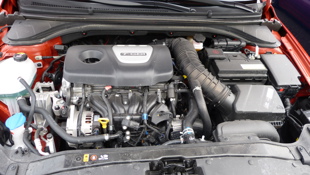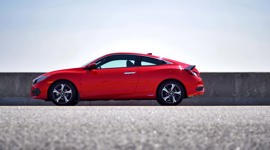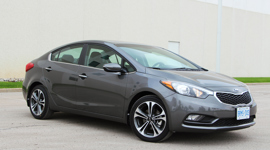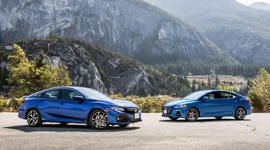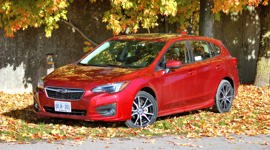Comparison Data
|
2017 Hyundai Elantra Sport
|
2017 Nissan Sentra SR Turbo
|
|---|---|
|
Engine Displacement
1.6T
|
1.6T
|
|
Engine Cylinders
4
|
4
|
|
Peak Horsepower
201 @ 6,000 rpm
|
188 @ 5,600 rpm
|
|
Peak Torque
195 @ 1,750 rpm
|
177 @ 2,000 rpm
|
|
Fuel Economy
10.7/7.8/9.4 l/100 km city/highway/combined
|
9.1/7.3/8.3 l/100 km city/highway/combined
|
|
Cargo Space
407
|
428
|
|
Base Price
$24,999
|
$21,598
|
|
A/C Tax
$100
|
$100
|
|
Destination Fee
$1,695
|
$1,600
|
|
Price as Tested
$26,794
|
$26,898
|
|
Optional Equipment
None
|
$3,700 – Premium Package ($3,400), three-coat paint ($300)
|
Review by Jacob Black and Sabrina Giacomini, photos by Jacob Black
They’re in the exact same segment – compact sedan. They’re almost the exact same price – within $100 of each other as tested. They both come with 1.6L, four-cylinder, turbocharged engines (YO!). And yet, these two cars come at the market from decidedly different directions.
The Nissan Sentra’s 188 hp/ 177 lb-ft 1.6L turbo is very much the underdog here on paper
At $26,898 the 2017 Nissan Sentra SR Turbo seeks to charm the compact sedan buyer with understated value. To prove that an economy car doesn’t have to be a penalty box, these seats are power operated and leather – baby.
The $26,794, 2017 Hyundai Elantra Sport also wants to prove that Korean cars aren’t all about doo-dads and knick knacks for your money – they can put a smile on your dial too.
So which of these high-value, lost-cost sedans should get your money?
Drive Train
The Nissan Sentra’s 188 hp/ 177 lb-ft 1.6L turbo is very much the underdog here on paper, but there are advantages. Sabrina Giacomini noted that the Sentra throttle response is initially faster, and that it seems to pull from a stop a little harder – at first. That’s despite giving up 13 hp and 18 lb-ft to the Elantra, which produces its 201 hp peak 400 rpm later than the Sentra's, at 6,000. It takes 250 rpm less time to get to its peak 195 lb-ft of torque though at 1,750 rpm.
The Sentra feels zippy, the Elantra feels punchy. Especially when speeds climb and it’s roll on time. Then, the Elantra picks it up and puts it down with a genuine enjoyment level that stands above all others barring close cousin, the Kia Forte. Indeed in our recent compact hatchback comparison this engine (albeit with a Kia badge) was overwhelmingly the group favourite.
Hyundai has tuned an exhaust note worthy of a “sport” badge, and the burbles, barks and low-end rumble from this tail pipe are thoroughly entertaining. The difference in the two cars was highlighted for me while Sabrina manoeuvered the cars for photos. The Elantra sounded fantastic, the Nissan, not so much.
Nissan’s manual transmission is not a match for the Hyundai unit either. Neither unit is as slick as VW, Mazda or Honda’s best efforts, but the Hyundai’s has a more consistent clutch point and a better defined shift pattern than the Sentra.
Sabrina goes even further. “Both come with a six-speed manual transmission and I have said in the past that the Elantra’s gearbox is perfect for anybody who wishes to learn to drive stick. The throws are precise and smooth, sadly something that was not replicated in the Sentra. Not that the tranny in the Sentra is bad; the Elantra’s is simply superior.”
For the aesthetically inclined, the Elantra shift knob is far more interesting than the Sentra’s bargain bin unit too.
Which is not to say the Nissan has no virtues. If your concerns are more worldly, Nissan has some tricks up its sleeve.
They have built an intriguing throttle sensation into the Sentra. It almost feels like the pedal has added resistance built into it and I find I like that aspect of it – making it easier to modulate throttle and giving a better sense of the response from your right foot.
Far more importantly, Nissan has worked hard to extract efficiency from this engine, and it shows. Over the course of our test loop we saw a difference of 1.8 L/100 km, 9.1 for the Sentra and 10.9 for the Elantra. Over the course of the week, I saw that gap narrow, but not by much. The Elantra ended the week at 10.3, the Sentra at 9.2.
Official ratings bear out this difference, with 9.1/7.3/8.3 L/100 km city/highway/combined for the Nissan and 10.7/7.8/9.4 for the Hyundai. That advantage is affected by the fact the Sentra takes premium unleaded and the Elantra can be run on regular. The difference in price might eat into any fuel savings you make with the Nissan.
Ride and Handling
Let’s let Sabrina handle this one:
“The Nissan Sentra was more comfortable on the road. Combine a quieter cabin with a smoother suspension and the experience feels more premium in the Sentra. The shock absorbers feel a little rougher in the Elantra.
“In terms of handling, the win goes to the Elantra hands down, proving the undeniable superiority of independent suspension over torsion beam when it comes to stability. Hyundai opted to fit the Sport with a set of multi link independent suspension, whereas Nissan stuck with a torsion bar. Not only does the Elantra Sport feel better grounded in the bends, it is also a lot steadier. It took me no time to meet the limits of the Sentra’s capacities and that was when the tires, rather than the fat lady, sang. Bonus: free Aria.”
Indeed, it’s the Sentra that offers the more composed, softer ride, while the Elantra is nimble, lively and a little crashy over big bumps. Again, the win for your writer goes to the Elantra. Many who lack my utter disdain for subtlety will disagree.
Noise and vibration
I was sure I’d left a window open, and pulled frantically on all four of the Elantra’s power-window buttons. It was the morning of photo day and I had already taken the Sentra through the car wash, now it was the Elantra’s turn. The machine gun spray of the water jets along the side of the Hyundai were loud, and frightening. This was the clearest example of how different the NVH in both cars is. Neither are class leading, but the Sentra is a far more relaxed environment.
If comfort is key, once again the Sentra wins that battle. Sabrina agrees with the statement, but not the sentiment. “The cabin in the Sentra is better sound proofed. You do get a lot more ambient noise in the Elantra Sport. On the other hand, and that could be because I like a more connected type of driving, the noise does not bother me. It feels part of the driving experience.”
Me, I like it quiet, and so with its quieter cabin, better damped suspension and overall gentler nature, it’s the Sentra in this category for me.
Interior and Exterior design
Dear Sentra, I am sorry, Love Jacob. Why? Because the Elantra interior is the single best looking interior under $25,000 (base price). Flat bottom, intricate, colourful steering wheel? Check. This, alluring, colourful shift knob? Check. I mean, sure, the bottom spoke of the Elantra steering wheel looks like a cloaca, but it’s still gorgeous. This is a genuine sports car interior albeit not in a sports car – no matter what AJAC says. It even has aluminum pedals.
As Sabrina says, “In the case of the Elantra, the Sport edition adds a flat-bottom wheel, red stitching and carbon fiber accents, or what I like to call 'The perfect little sports car starter kit.' These features are pretty much the obvious go-to’s when it comes to branding a vehicle as “sporty.”
“The Sentra is more sober, sticking to the classic Nissan aesthetics with silver accents on black, with a slightly blander console.”
If the Elantra is done up in its best clubbing gear, the Sentra looks ready to take on a rollicking game of Cribbage. Sorry Sentra – the Elantra gives you a spanking here.
It doesn’t get much better on the outside.
“Even though they are approximately the same size, the proportions of the Elantra’s design are better balanced and more dynamic. Granted, the Sentra looks like a miniaturized version of the striking Maxima, but the Elantra has a design of its own, better fitted to its size.”
And while yes, aesthetics are subjective, there are some obvious areas where the Elantra takes it to the next level. Consider the back end for example, where a diffuser (lol) and twin exhausts add a dimension of flair that the Sentra with its single exhaust tip and simple cladding can’t compete. Plus Nissan has to leave visual and market room for the new and pricier Nissan Sentra Nismo, which has much more aggressive design cues.
On the outside they're both well-dressed, but the Elantra is just hotter.
Features and Gadgets and Things
Take it away, Sabrina: “At just $104 more, the Nissan offers more equipment than the Hyundai such as power seats and navigation. I had the conversation with Jacob who pointed out that the Elantra Sport does offer Android Auto/Apple CarPlay, which is a fair point.”
I hear a “but” coming….
“That is, if like him, you have unlimited data and can just stream to your heart’s desire using your cellphone. I don’t, so having to use my own data to navigate over enjoying a worry-free cruise thanks to a proper GPS set up, like the one offered in the Sentra, is a concern.”
Sabrina makes a fair point on the data issue, and I am an overwhelmingly big Android Auto fanboy, so it’s reasonable to temper that. But on the subject of equipment, I submit to you the one thing all Canadians need: a heated steering wheel. Okay, maybe not all Canadians, but all Australian imports definitely need it. Many have pointed out that a heated steering wheel is actually a pretty cheap thing to whip into a car, but it’s still a very, very welcome thing.
For Nissan’s part, you get power seats which the Elantra doesn’t have, as well as an eight-speaker BOSE premium audio system. Those are part of the Premium Package that added $3,400 to the $21,585 Sentra and brought it up to Elantra Sport pricing level. That Premium Package also adds 5.8-inch touchscreen, auto-dimming rear-view mirror, illuminated vanity mirrors (WOW!) the aforementioned navigation and Nissan Connect – which is an attempt at mobile connectivity we feel falls short. Just go Android/Apple Nissan, please?
The Nissan does have a nice gauge cluster and a bigger, richer TFT between the gauges, but I’d still give this creature comfort win to Hyundai.
Space
Here I expected the 65mm longer and 60 mm higher Sentra (4,635 mm and 1,495 mm respectively) to trounce the Elantra soundly, but it doesn’t. Neither car feels crowded and I couldn’t split the difference despite spending a solid half hour jumping in and out of each.
Sabrina agrees: “This one is definitely a tie. They were both equally, and surprisingly, spacious. At 5ft8, the backseat of a car can sometimes feel crammed, but neither compact sedans had me yoga my way into their seats. Access was easy.
“The sloping roofline on both models could potentially be a problem for taller people, but in terms of legroom, they both get an A.”
Our findings are backed up by the stats, which show 2713 L of passenger volume for the Elantra and only 3L more for the Sentra. The Sentra does get 21 L more cargo volume in its 428 L boot. However, the larger boot comes with no pull-down handle, whereas the Elantra’s does. So expect a lot of irritating dirty finger prints in your Nissan Sentra future.
And the Winner Is
“If the world was made entirely of Nissan Sentra SR and Hyundai Elantra Sport, the Sentra would be a premium sedan with a sport package and the Elantra, a sports car.
“The Elantra is tuned to be sportier, but it is also more raw. The Sentra on the other hand is better built, but also a lot more tame,” says Sabrina.
Despite the nearly identical as-tested prices, the Sentra is at its core a cheaper car with an expensive options package. It’s funny, but without the power seats, navigation and Bose audio system the $3,400 saving might be enough to ratchet the Sentra to a narrow win in this fight.
But the Elantra is our hands down winner. Hyundai not only has produced a stunning power plant, but wrapped it in an alluring package both inside and out. They’ve shown their skill at choosing exactly the right places to spend their money in order to extract tangible value for the buyer, and at the same time built a car we thoroughly enjoy driving.





















